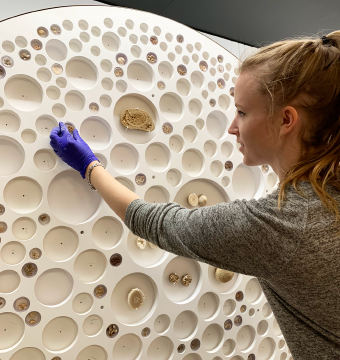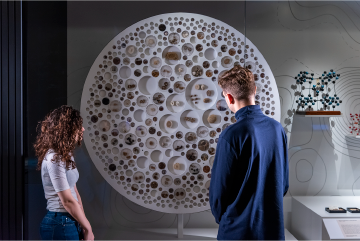Caring for the Science Museum Group Collection
Tags
The Science Museum Group aims to inspire visitors with award-winning exhibitions, iconic objects and stories of incredible scientific achievement. Our world-class collection forms an enduring record of scientific, technological and medical advancement from across the globe.
Human remains have a unique status within museum collections. We treat them with the highest standards of care and respect, following HTA standards and national guidelines for museums. Where we display human remains, we ensure they are displayed in an appropriate context with suitable interpretation.
We care for 4,392 human remains from many different countries and historical periods. They include skeletal material, mummies, artefacts incorporating remains and slides containing human tissues. The largest group of human remains is 2,728 sets of gallstones, which is held under our HTA licence. Many of these gallstones can be seen on display in Medicine: The Wellcome Galleries at the Science Museum.
Human tissue under 100 years old forms a subset of the human remains held within the Science Museum Group Collection. These remains support research into and the public understanding of cultural and medical practices, biological processes, genetics, diet, disease and population movements over time.
An example of the surprising and powerful stories that we can tell through the sensitive display of human tissue is contained in Mathematics: The Winton Gallery at the Science Museum. A small wooden cabinet contains microscope slides prepared by pathologist Dr Christopher Wagner. Many of these slides contain tissues showing the harmful effects of exposure to asbestos.
Some of the slides relate to cases that Wagner described in his 1960 research paper ‘Diffuse Pleural Mesothelioma and Asbestos Exposure in the North Western Cape Province’. In this paper, published in the British Journal of Industrial Medicine, Wagner, with his colleagues C. A. Sleggs and P. Marchand, made a causal link between exposure to blue asbestos (crocidolite) and the lung cancer, mesothelioma. In 28 of the cases presented, there was an association with the asbestos mountains in the Cape Province of South Africa.
The paper caused a furore. It ultimately impacted industry worldwide, and the dangers of asbestos have been accepted. Control, containment and disposal of asbestos is enshrined in law in many countries, and remains an ongoing public health concern. The human tissue, now displayed in the Science Museum, enabled Wagner to draw his important conclusions. Seeing the display helps our visitors understand this important story.
The Human Tissue Authority’s guiding principles are a good fit with the principles of managing collections in museums. No human tissue has entered the collection since the Human Tissue Act came into force in 2005; the principle of dignity underpins the way that we display and store human remains.
The principle of honesty and openness is reflected in our code of conduct for colleagues. As part of our commitment to transparency, we publish our collections management policies and human remains policy on the Science Museum website. The principle of quality (including clean and well-maintained premises and careful and competent staff) is obvious to anyone visiting the excellent displays at the Science Museum, where we welcome around three million people each year. Less visible is the highly skilled work that takes place behind the scenes to safely store the collection and make it accessible.
In 2024 we opened the Hawking Building, an innovative collection management facility that provides a sustainable new home for the Science Museum Group Collection. Housed at the Science and Innovation Park in rural Wiltshire, over 300,000 historic items were carefully moved into the new facility, from a toy duck used by scientists to identify landing sites on a comet to a 1.3-tonne Sno-cat, the first vehicle to complete a motorised crossing of Antarctica, and hundreds of items from Professor Stephen Hawking’s office. Pre-booked public tours of the facility (which do not include human remains) are already proving very popular.
The Hawking Building enables the Science Museum Group to better store, conserve, research and digitise our unique collection, while also improving the process of displaying items across the Group’s five museums. It is also where we can provide research access to human tissue. We were pleased that an inspection of our sites by the Human Tissue Authority in December 2024 demonstrated that we are meeting the HTA’s standards.
Managing human tissue is only a small part of what we do at the Science Museum Group, but it is one taken seriously by everyone involved. We are always happy to share our knowledge and practice with colleagues in museums across the UK.
Jack Kirby
Associate Director of Collections Services and HTA Designated Individual for the Science Museum Group


